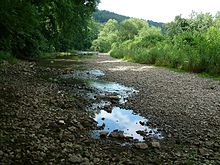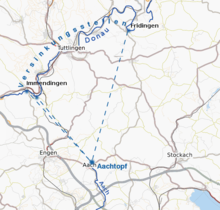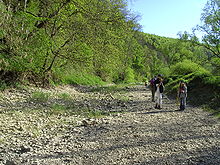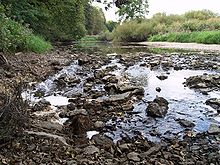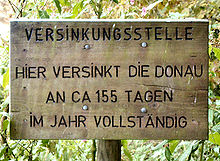- Danube Sinkhole
-
The Danube Sinkhole (German: Donauversinkung or Donauversickerung) is an incipient underground stream capture in the Upper Danube Nature Park. Between Immendingen and Möhringen and also near Fridingen (Tuttlingen), the water of the Danube sinks into the riverbed in various places. The main sinkhole is next to a field named Brühl between Immendingen and Moehringen.
The term "sinking" is more accurate then "seeping", because the water is not easily distributed in the soil. It flows through underground caverns to Aachtopf, where it emerges as the river Radolfzeller Aach.
Contents
Hydrography
The sinking Danube water disappears into a karst water system of the well-stratified limestone formation (the ox2 layer) of the White Jura and appears again in a horizontal limestone layer (the ki4 layer), approximately twelve kilometers away at Aachtopf.[1] It then flows as Radolfzeller Aach into Lake Constance at Radolfzell. Thus, a part of the Danube water also flows into the Rhine. This geographical situation is a striking feature of the large European Watershed, which separates the catchment areas of the North Sea and the Black Sea.
The water flows out through a variety of small to very small cracks and crevices; the karst in these places is apparently at an early stage of development. The cave system of Aachtopf, that is the underground river Danube is, however, probably already well developed. The can be inferred from the tight correlation in water temperatures of the Danube and Aachtopf spring which matches the behaviour of an underground river better than a branching system.
In the 1960s, Jochen Hasenmayer has discovered and explored the first 400 meters of a large clam-shaped hole called the Aachhöhle.
History
The first documented case of the Danube completely disappearing into the hole, dates back to 1874.[2] Since then, the number of days per year when this happens, has risen sharply. Between 1884 and 1904, it happened, on average, 80 days per year. In 1922, it happened only on 29 days. In 1923, however, the number increased to 148. Between 1933 and 1937, the average was on 209; from 1938 to 1945, it was 270 days. The highest number so far, was in 1921, with 309 days.
The relationship between the sinkhole and Aachtopf spring was proven in October 1877. Geologist Adolf Knop of the Karlsruhe Institute of Technology poured 10 kg of sodium fluorescein, 20 tons of salt, and 1200 kg of shale oil into the Danube on 9 October. After 60 hours, all three substances emerged at the Aachtopf. The water at Aachtof was described as "gorgeously green lit" by the fluorescein and tasting of creosote.[3][4]
Later, the connection of the individual sinkholes was explored. In about 1908, a shaft was dug in Fridingen in an attempt to find out where the water of this sinkhole goes.[5]
In 1927, a case was brought before the Supreme Court of the German Reich between the countries Württemberg and Prussia as the ruler of the Hohenzollern Province on the one hand and the state of Baden on the other hand, to decide the smoldering controversy over the quantitative impact of the Danube sinkhole, which is known as Danube Sinkhole case (German: de:Donauversinkungsfall).
Outlook
As the karst is developing, future sinkhole stretches are not exactly predictable. The underground river Danube annually removes about 7,000 tons of lime, that is 2,700 cubic meters, from the karst system. Future expansions or collapses in the underground system are conceivable; these would show above ground as sinkholes or ponors.
In the long run today's upper Danube will probably be redirected entirely into Radolfzeller Aach, and thus to the Rhine. Then would mean that the currently insignificant tributaries Krähenbach (in Möhringen) and Elta (in Tuttlingen) would become the new headwaters of the Danube. The Danube has experienced a similar stream capture further upstream, during the Würm glaciation, when the Feldberg-Danube was captured by the Wutach at the Wutach Gorge near Blumberg.
External links
- Nachlese: Report on search for the underground river Danube
- Testimony of the discovery of the Danube cave
- Website about the construction of access to and further exploration of the Danube cave
- This page is a translation of its German equivalent.
Footnotes
- ^ H. Binder: Höhlenführer Schwäbische Alb, H. Jantschke 7th ed, 2003; p. 260
- ^ Höhlenführer, p. 261
- ^ A. Knop: Über die hydrographischen Beziehungen zwischen der Donau und der Aachquelle im badischen Oberlande, in: Neues Jahrbuch für Mineralogie, Geologie und Paläontologie, E Schwiezerbart, Stuttgart, 1878, pp. 350–363.
- ^ H. Hötzl (1996): Origin of the Danube-Aach system, in: Environmental Geology, vol. 27, Nr. 2, pp. 87-96, doi:10.1007/BF01061676
- ^ Supreme Court of the German Empire Decisions of the Supreme Court in Civil Matters 116, Appendix p. 24
Coordinates: 47°55′56″N 8°45′49″E / 47.932173°N 8.763528°E
Wikimedia Foundation. 2010.

